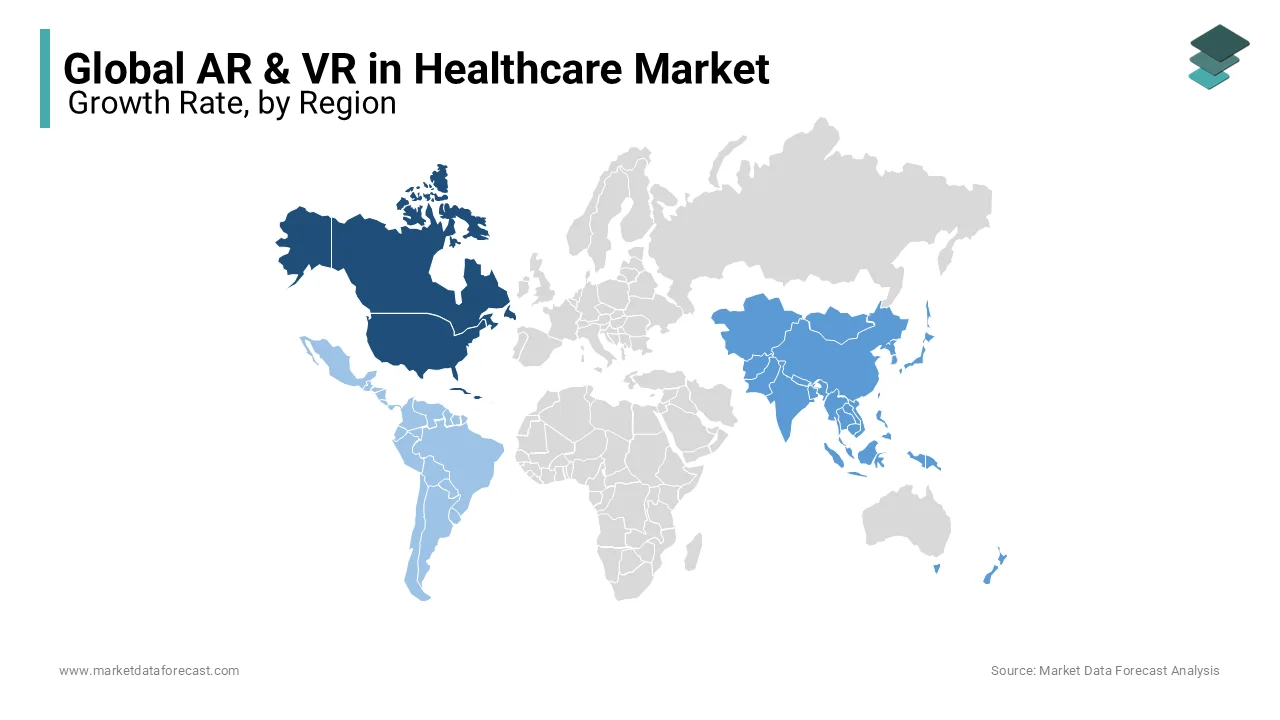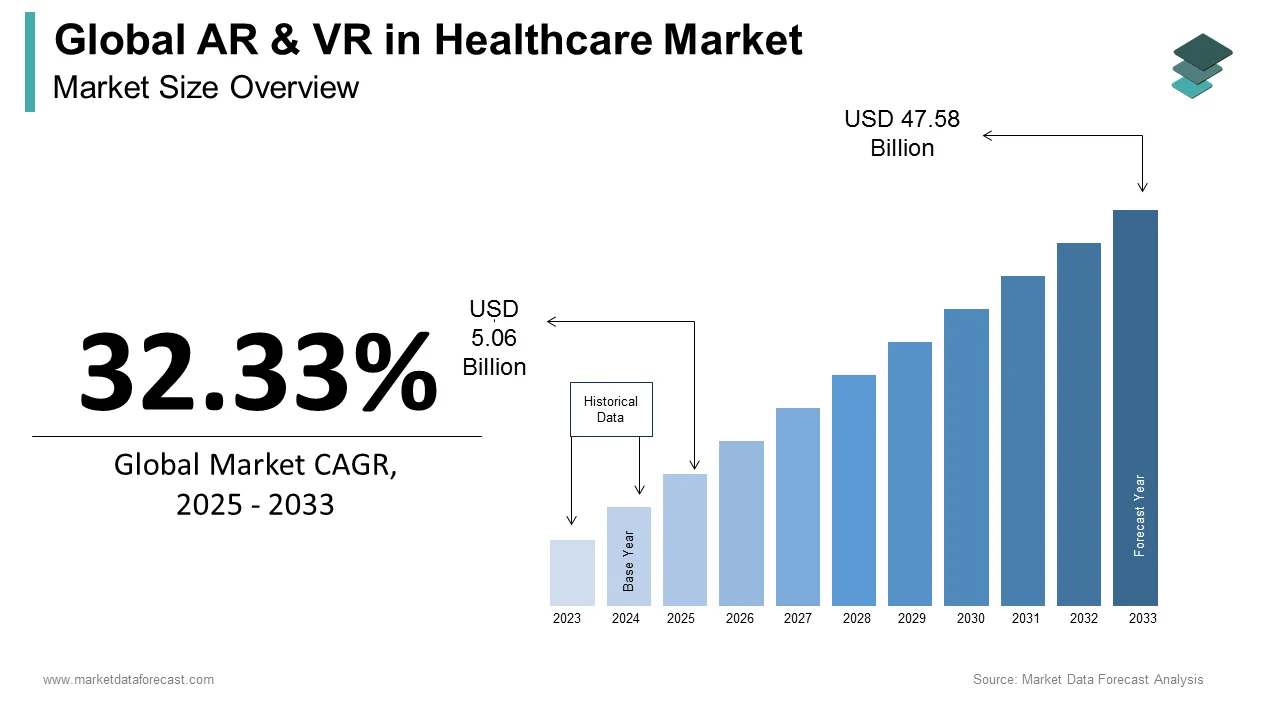Global AR & VR in Healthcare Market Size, Share, Trends & Growth Forecast Report By Component, Technology and Region (North America, Europe, Asia-Pacific, Latin America, Middle East and Africa), Industry Analysis From 2025 To 2033.
Global AR & VR in Healthcare Market Size
The size of the global augmented reality & virtual reality in healthcare market was worth USD 3.82 billion in 2024. The global market is anticipated to grow at a CAGR of 32.33% from 2025 to 2033 and be worth USD 47.58 billion by 2033 from USD 5.06 billion in 2025.
MARKET DRIVERS
Medical Education Advancements
Y-O-Y's growth in the usage of augmented reality and virtual reality in healthcare and medicine is majorly driving the global AR & VR in healthcare market growth. The usage of AR & VR in medical education has seen rapid growth in the recent past. Medical students, doctors, and surgeons can learn how to manage their patients better or conduct complex operations without risking surgery errors. Robotic surgery is when robots perform high-precision surgeries under the supervision of a human surgeon using virtual reality technology. In addition, the adoption of AR & VR in physical therapy is expected to grow enormously soon, which is estimated to boost the global AR & VR growth rate in healthcare. When performing the physical treatment, VR assists patients in overcoming high pain levels and ensuring a speedier recovery. This is known as post-traumatic stress treatment, when a person is placed in a terrible circumstance and attempts to find a solution and overcome the crisis. Treatment for anxiety, phobias, and depression - patients can utilize virtual reality to meditate or relax in safe situations. People can locate medical centers, pharmacies, and other healthcare institutions using AR maps superimposed over reality.
Growth in Mobile and Internet Usage Driving AR & VR in Healthcare
Growing usage of the Internet and small phones across the globe and increasing mobile apps for healthcare based on virtual reality are further expected to drive AR & VR in healthcare market growth. Virtual Reality is further used in medical training, pain management and physical therapy, early disease detection and treatment, and assisting people with low vision. The use of augmented reality in health reality is one of the hottest technologies that all industries seeking digital transformation are attempting to investigate and utilize. Today, augmented reality is being applied in healthcare. Augmented Surgery, Describing Symptoms, Nursing Care, and Pharmacy are just a few ways this technology can be employed in healthcare. An increase in the use of technologically advanced products and devices. Virtual reality is quickly becoming one of the most intriguing developments in the medical field. It has aided in the advancement of healthcare outcomes. AR is one of the most recent innovations, with gaming, health, automotive, and retail applications.
Technological Advancements Accelerating AR & VR in Healthcare
Rapid technological advancements in the healthcare sector are another significant factor accelerating the global AR & VR in healthcare market growth. Despite numerous breakthroughs in the healthcare sector, augmented reality and virtual reality technologies are game changers. AR and VR will make all this feasible, from teaching medical practitioners to virtual procedures, remotely consulting patients, and advanced diagnostics. As a result of technological improvements, various healthcare applications have been developed that provide far better and faster services. We can receive any information anywhere with just one click on our smartphones. From medical examination to treatment, surgery to patient care, virtual reality helps to improve the quality and efficiency of services. Virtual Reality technologies offer color to the medical business while improving overall medical quality. In addition, the use of technology has drastically improved communication, simulation, treatment, and healthcare research. Soon, AR/VR will be widely used in healthcare for intraoperative surgery, healthcare professional training, physiotherapy, better diagnostics, anatomy, visualization, and much more.
Impact of Connected Devices on AR & VR in Healthcare Market Growth
Y-O-Y growth in the usage of connected devices in healthcare is predicted to favor the AR & VR in healthcare market growth. Healthcare changes dramatically because of technological developments, from Healthcare Connected Devices that are applicable by utilizing IoT, mHealth, and Artificial Intelligence in the healthcare sector anesthetics and antibiotics to magnetic resonance imaging scanners and radiotherapy. Regarding connectivity, there are two options that are wired and wireless. The Internet of Medical Things (IoMT) is a network of medical devices, software applications, and health systems and services connected. Connected medical devices are already making their way into everyday life.
Increasing healthcare investments in AR & VR and increased Internet of things (IoT) adoption are further estimated to support the global AR & VR in healthcare market. IoT, mHealth, and Artificial Intelligence in healthcare make Healthcare Connected Devices possible. IoT, mHealth, and Artificial Intelligence in healthcare make Healthcare Connected Devices possible. Additionally, opportunities in emerging economies, Y-O-Y growth in the geriatric population, increased adoption of AR & VR in clinical trials, psychiatric treatment, improved diagnostics, and operations are expected to boost the growth rate of the global AR & VR in the healthcare market. AR and VR for Surgery Provide Preparation and Efficiency, and VR Provides Medical Immersion for a Variety of Patient Needs.
MARKET RESTRAINTS
High Product and Device Costs
High product and device costs, a shortage of experienced personnel, privacy concerns, and data security are key factors expected to restrain the growth of global AR & VR in the healthcare market. The Internet of Medical Things (IoMT) is a networked infrastructure of medical devices, software applications, health systems, and services. Several businesses lack the digital skills necessary to implement these technologies correctly. There's also the possibility of fragmentation and the dangers of competing capabilities across different hardware platforms and operating systems. With the use of VR or AR, there are risks to corporate operations.
REPORT COVERAGE
|
REPORT METRIC |
DETAILS |
|
Market Size Available |
2024 to 2033 |
|
Base Year |
2024 |
|
Forecast Period |
2025 to 2033 |
|
Segments Covered |
By Component, Technology, and Region |
|
Various Analyses Covered |
Global, Regional & Country Level Analysis, Segment-Level Analysis, Drivers, Restraints, Opportunities, Challenges; PESTLE Analysis; Porter’s Five Forces Analysis, Competitive Landscape, Analyst Overview of Investment Opportunities |
|
Regions Covered |
North America, Europe, Asia Pacific, Latin America, Middle East & Africa |
|
Market Leaders Profiled |
Google, DAQRI, Microsoft, AppliedVR, Mindmaze, Oculus VR, HTC Corporation, Firsthand Technology, Psious, Atheer, Medical Realities, Hologic, Inc, Augmedix, 3D Systems. |
SEGMENTAL ANALYSIS
By Component Insights
The hardware segment is predicted to dominate the global augmented reality and virtual reality in healthcare market during the forecast period. Devices like head-mounted displays, smart glasses, and 3D sensors dominate the market for AR and VR in healthcare. Smart glasses and head-mounted devices are widely utilized in training and simulation, surgery, diagnostics, tele-mentoring, and various other applications. AR/VR hardware now has a widely developed product base with a high adoption rate, particularly in developed nations, which accounts for the most significant market share in 2024.
Due to recent technical developments in in-app designing, such as applications such as EyeDecide, the Software segment is predicted to grow rapidly throughout the forecast period. It measures a variety of characteristics to detect eye problems. In addition, interconnectivity and network services that let patients gain access to these platforms have advanced dramatically in recent years.
By Technology Insights
The augmented reality segment is estimated to lead the global AR & VR in healthcare during the forecast period. With wearable head-mounted display devices and smart glasses, augmented reality generates a 3D picture of things and our environment.
The virtual reality segment is predicted to increase significantly during the forecast period. Virtual reality allows users to engage with a three-dimensional environment, opening new rehabilitation and pain treatment opportunities. Virtual Reality exposure therapy is a therapeutic method for phobias like fear of heights, driving, claustrophobia, and posttraumatic stress disorder. Factors such as the increased need for innovative diagnostic procedures and an increase in neurological illnesses drive the market forward.
REGIONAL ANALYSIS

The North American region is predicted to dominate the global market during the forecast period. Higher use of these technologies, investment in R&D efforts, and favorable government efforts are a few of the key factors driving the North American market. Factors contributing to this dominance include increased government and private funding for developing these technologies and the presence of major manufacturers and vendors in the region. In addition, the US government is providing funding for virtual reality research with a focus on healthcare. The Americas have also risen to the top due to continuous improvements in the information technology industry and government backing to promote the use of AR/VR technologies in the medical industry. Because of the high acceptance rate of technology, more healthcare expenditures, and increasing government programs, the United States remains the most profitable market in the area.
Due to rising population awareness and improved healthcare infrastructure, the Asia Pacific region is predicted to be the fastest-growing market throughout the forecast period. Developing economies like India, China, Brazil, and Mexico are attractive outsourcing destinations for AR and VR technology development and distribution in healthcare.
Due to increased investment in innovations and a boom in technological developments, the European region continues to do well the worldwide market.
Latin America and MEA are predicted to account for a moderate worldwide market share during the forecast period.
KEY MARKET PARTICIPANTS
Some of the notable participants in the global AR & VR in Healthcare market covered in this report are Google, DAQRI, Microsoft, AppliedVR, Mindmaze, Oculus VR, HTC Corporation, Firsthand Technology, Psious, Atheer, Medical Realities, Hologic, Inc., Augmedix, 3D Systems, Alphabet, Inc, SAMSUNG, Orca Health LLC, and CAE HEALTHCARE.
MARKET SEGMENTATION
This research report on the global AR & VR in healthcare market has been segmented and sub-segmented based on component, technology, and region.
By Component
- Hardware
- Software
- Services
By Technology
- Augmented Reality
- Surgical Application
- Rehabilitation
- Training & Medical Education
- Virtual Reality
- Simulation
- Diagnostics
- Virtual Reality Exposure Therapy (VRET)
- Rehabilitation
- Pain Distraction
By Region
- North America
- The U.S.
- Canada
- Rest of North America
- Europe
- UK
- Germany
- Italy
- Spain
- France
- Rest of EU
- APAC
- India
- China
- Japan
- South Korea
- ANZ
- Rest of APAC
- Latin America
- Mexico
- Brazil
- Argentina
- Chile
- Rest of Latin America
- Middle East & Africa
Frequently Asked Questions
How big is the global AR & VR in healthcare market?
As per our research report, the global augmented reality and virtual reality in the healthcare market will reach USD 47.58 billion by 2033.
Which region is predicted to play a dominating role for the AR & VR in healthcare in the global market in the coming future?
Between 2025 to 2033, the North American region is expected to lead the global augmented reality and virtual reality in healthcare market.
What are some of the leading companies in the global AR & VR in healthcare market?
Google, DAQRI, Microsoft, AppliedVR, Mindmaze, Oculus VR, HTC Corporation, Firsthand Technology, Psious, Atheer, Medical Realities, Hologic, Inc, Augmedix, 3D Systems, Alphabet, Inc, SAMSUNG, Orca Health LLC, and CAE HEALTHCARE are a few of the key players in the market.
Related Reports
Access the study in MULTIPLE FORMATS
Purchase options starting from
$ 2500
Didn’t find what you’re looking for?
TALK TO OUR ANALYST TEAM
Need something within your budget?
NO WORRIES! WE GOT YOU COVERED!
Call us on: +1 888 702 9696 (U.S Toll Free)
Write to us: sales@marketdataforecast.com


